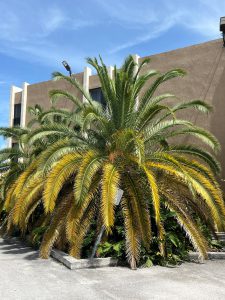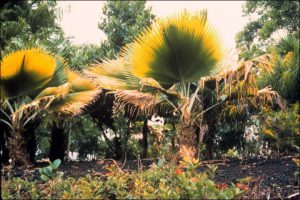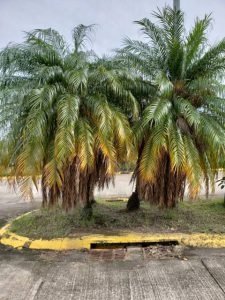Magnesium (Mg) deficiency is very common in palms in Florida. Why is that? It’s because our soils have very low cation exchange capacity (CEC) and are highly leachable. CEC is a measurement of the total negative charges in the soil particles, thus allowing adsorption of positive charged nutrients such as Magnesium (Mg +2), Calcium (Ca +2), and Potassium (K+1). Lower CEC values indicated less cations in the soil profile, thus less nutrients available for the palms. Why is Magnesium important? If you remember from your biology class, Magnesium is the central element of the chlorophyll molecule! Each molecule contains approximately 7% of Magnesium, so a Magnesium deficiency in the soil will cause yellowing of the palm’s fronds.
The deficiency appears on the oldest fronds as a chlorotic (yellow) band along the margins with the central portion of the leaves remaining green resembling a Christmas tree. Frequently, Magnesium and Potassium deficiencies coexist on the same palm, the oldest leaves will show typical K deficiency symptoms, while Mg deficiency symptoms will be visible on mid-canopy. The good news is that Magnesium deficiency is never fatal in palms, unlike Potassium deficiency which could be lethal.




Management
Due to the chemistry of our soils, Magnesium deficiencies are difficult to correct once symptoms are present. It will require at least one or two years! For palms in landscapes with Magnesium deficiency, Mg should be included in the fertilizers in a controlled-release form such a kieserite (monohydrate form of magnesium sulfate). For severely deficient palms, it is recommended to broadcast two to five pounds of kieserite under the canopy four to six times per year. This treatment should be considered as a supplement to regular applications of a balanced 8-2-12+4Mg palm maintenance fertilizer.
Literature:
Magnesium deficiency in palms, https://edis.ifas.ufl.edu/publication/EP266
Palm nutritional deficiencies https://gms.ctahr.hawaii.edu/diseasespests.aspx?aid=1547
Thanks Donna Castro, UF/IFAS Broward Extension and Jeff Wasielewski, UF/IFAS Miami-Dade for your help!
Related Posts
The Peanut Butter Challenge—It’s Good to Go Nutty!
All About Saturated Fat
Privacy Overview
| Cookie | Duration | Description |
|---|---|---|
| cookielawinfo-checkbox-analytics | 11 months | This cookie is set by GDPR Cookie Consent plugin. The cookie is used to store the user consent for the cookies in the category "Analytics". |
| cookielawinfo-checkbox-functional | 11 months | The cookie is set by GDPR cookie consent to record the user consent for the cookies in the category "Functional". |
| cookielawinfo-checkbox-necessary | 11 months | This cookie is set by GDPR Cookie Consent plugin. The cookies is used to store the user consent for the cookies in the category "Necessary". |
| cookielawinfo-checkbox-others | 11 months | This cookie is set by GDPR Cookie Consent plugin. The cookie is used to store the user consent for the cookies in the category "Other. |
| cookielawinfo-checkbox-performance | 11 months | This cookie is set by GDPR Cookie Consent plugin. The cookie is used to store the user consent for the cookies in the category "Performance". |
| viewed_cookie_policy | 11 months | The cookie is set by the GDPR Cookie Consent plugin and is used to store whether or not user has consented to the use of cookies. It does not store any personal data. |



